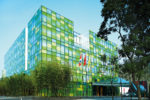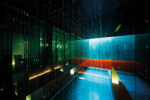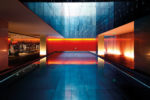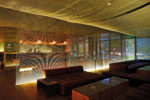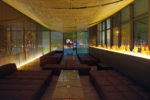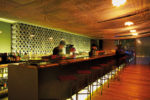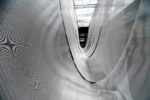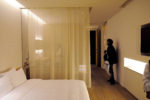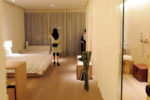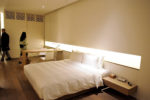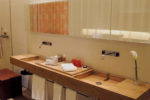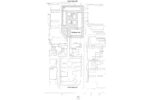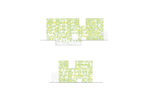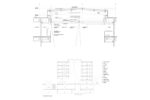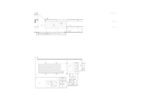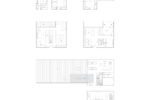architect: Kengo Kuma
location: Beijing, China
year: 2008
The current main stream for urban development in the world is the combination of super-skyscrapers + plazas. However for this project, we tried to reproduce a human-scale, maze-like space within the city by using medium rise architectures. The project is divided into the South district and the North district. For the South District, a Chinese street style called Hutongs was referred to. The street is slightly curved and twisted to produce the maze-like characteristic. For the North district, a courtyard house called Siheyuan was referred to. Two enclosures were created, the exterior and inner enclosure, and at the center of the two enclosures, a sunkun garden with dense plants was designed. To realize human-scale spaces that existed in the Hutongs and the Siheyuan, large and plain surfaces were avoided for the skin of the architecture. The skin was divided into smaller mosaic panels. For the details of each individual panel, we tried to create an expression which would change depending on the condition of the light, similar to the skin of a creature, by using acrylic bars with multiple colors and ceramic printing technique with patterns modified from Chinese traditional lattice screen.
Kengo Kuma was Born in Kanagawa, Japan in 1954. He completed his master’s degree at the University of Tokyo in 1979. From 1985 to 1986, he studied at Columbia University as Visiting scholar. He established Kengo Kuma & Associates in 1990 in Aoyama, Tokyo. Since 2001 he has been a professor at the Faculty of Science and Technology of Keio University. Among Kuma’s major works are the Kirosan Observatory (1995), Water/Glass (1995, for which he received the AIA Benedictus Award), Venice Biennale/Space Design of Japanese Pavilion (1995), Stage in Forest, Toyoma Center for Performance Arts (1997, for which he received the 1997 Architectural Institute of Japan Annual Award), Stone Museum (2000, for which he received International Stone Architecture Award 2001), Bato-machi Hiroshige Museum (2001, for which he received The Murano Prize). Recent works include Great Bamboo Wall (2002, Beijing, China), Nagasaki Prefectural Museum (2005, Nagasaki, Japan) and the Suntory Museum of Art (2007, Tokyo, Japan). A number of large-scale projects are now going on in Europe and China, such as an arts centre in Besancon City, France, and the development of the Sunlitun District in Beijing, China. He was awarded the International Spirit of Nature Wood Architecture Award in 2002 (Finland), International Architecture Awards for the Best New Global Design for “Chokkura Plaza and Shelter” in 2007, and Energy Performance + Architectutre Award in 2008 (France).
project name: The Opposite House
client: Swire Hotels
planning and designing period: August – November 2005, October 2006 – June 2007
construction period: May – October 2006, October 2007 – August 2008
location: Beijing, China
principal use: Boutique Hotel
site area: 4,548 square meters
total floor area: 14,328 square meters
scale: 6 stories above ground, 2 basement levels, 99 Guest Rooms
design: Kengo Kuna and Associates
architecture: Kengo Kuma, Yuki Ikeguchi, Jun Shibata, Jun Florian Peine
interior design:
guest rooms: Kengo Kuma, Yuki Ikeguchi, nStudio (Kenichi Ueki, Akito Ito) *cooperation in design development phase
public area: Kengo Kuma, Yuki Ikeguchi, Jun Shibata
structural engineers: Arup Beijing, Beijing Architectural & Engineering Design
mechanical engineers: China/ Team
lighting design: Isometrix
art consultant: Alison Pickett
photo: Katsuki Miyoshino
portrait photo: dbox


